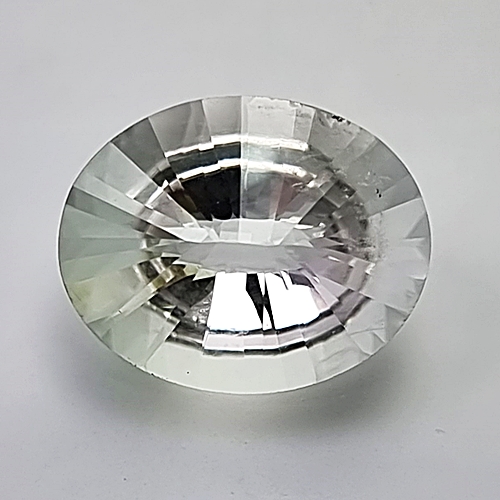Apophyllite: Gemstone Information
Apophyllite, a name well known to mineral collectors rather than gemmologists on account of the beautiful green crystals from India, is not now a valid mineral species under that name. The names fluorapophyllite, hydroxy apophyllite or natro apophyllite should be used according to the composition of particular specimens. These species are members of the apophyllite group. Most apophyllite likely to reach the collector or gemmologist will be fluorapophyllite which forms a series with hydroxy apophyllite. Fluorapophyllite has the composition KCa4Si8O20 (F,OH)8H2O. It is a member of the tetragonal system, occurring in various habits with a perfect basal cleavage.
The hardness and SG are 4.5–5 and 2.33–2.37. The RI is 1.530–1.536 for the ordinary ray and 1.532–1.538 for the extraordinary ray. The birefringence is small and may be positive or negative. Neither characteristic absorption spectrum nor luminescence has been recorded. Apophyllite occurs in basalts and granites, specimens from the Poona, Nasik and Mumbai (Bombay) areas of India easily excelling all others. Other world localities can be found in mineral textbooks but their specimens are rarely used ornamentally. Mont Saint Hilaire, Quebec, Canada, has produced variously colored specimens. Apophyllite has a notably pearly luster and may be colorless, pink, yellow or green, none being a strong shade.
Apophyllite is a beautiful and unique gemstone that is known for its powerful metaphysical properties and is often used in crystal healing. It is a relatively rare mineral, belonging to the family of phyllosilicates. The name “apophyllite” is derived from the Greek words “apo,” which means “off,” and “phyllon,” which means “leaf,” due to its tendency to flake or peel when heated, as discovered by the German geologist Abraham Gottlob Werner in the 19th century.
Apophyllite Gemstone Overview
Apophyllite is a mesmerizing gemstone renowned for its ethereal beauty and profound spiritual properties. Originally named after its propensity to flake upon heating, this mineral belongs to the Phyllosilicate family and is available in various colors, including white, green, blue, yellow, pink, and colorless forms
Physical and Metaphysical Properties
Physically, apophyllite is a semiprecious gemstone with a hardness ranging from 4.5 to 5 on the Mohs Scale. It exhibits low birefringence, giving it a nearly isotropic appearance. Metaphysically, apophyllite is strongly linked to the crown chakra, fostering spiritual awareness and intuitive development
Healing and Spiritual Benefits
Apophyllite is considered a powerful tool for clearing negativity, reducing stress, and promoting emotional stability. It is believed to enhance mental clarity, increase creativity, and foster a deeper connection to the spiritual realm. Additionally, apophyllite is associated with the following benefits:
- Promoting inner peace and emotional healing
- Facilitating astral travel and spiritual vision
- Connecting with higher realms and spiritual guides
- Accessing the Akashic Records
- Assisting in Reiki healing sessions
Green apophyllite, although rare, carries specific properties related to growth, inner peace, and increased connection to nature
Uses and Applications
Apophyllite is primarily appreciated for its metaphysical properties rather than its use in jewelry. It is often displayed in homes for Feng Shui purposes, carved into sculptural pieces, or used in spiritual practices such as meditation, Reiki, and Tarot readings
Care and Maintenance
To preserve the integrity of apophyllite, follow these guidelines:
- Clean with a soft brush, mild soap, and lukewarm water. Avoid using harsh chemicals or abrasives.
- Store separately from other gemstones to prevent scratches.
- Perform energetic cleansing techniques, such as smudging with sage or charging under moonlight, to refresh the stone’s energy field
- By understanding the rich history and diverse applications of apophyllite, you can better appreciate this remarkable gemstone and incorporate it into your personal or professional life.
-
Buy Apophyllite Gemstones Online at http://Gemfame.com Call for details at Mobile +91 9444456511, Landline +91 44 42333655.





